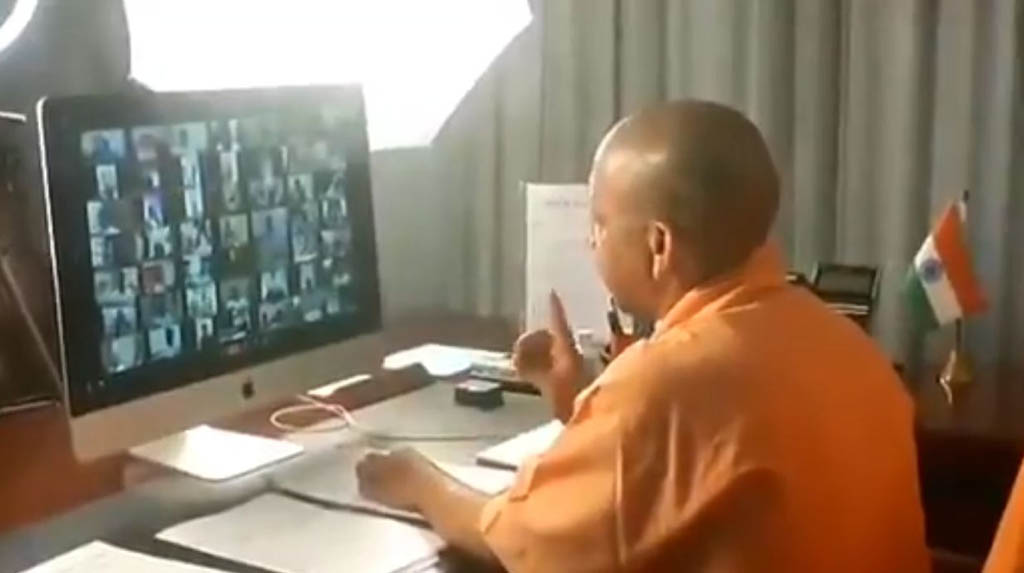New Delhi: In the most populous state of India, Chief Minister Yogi Adityanath’s daily war with the pandemic begins much before the sun rises in the city of Avadh. At 4 a.m. every day, Yogi leaves his bedroom and by the next couple of hours, he is fully updated with situation reports from all the 75 district magistrates, including two police commissioners of Uttar Pradesh. By 7 a.m. Yogi picks up the phone and starts instructing key officials across the state, where he feels extra attention is required to contain the dreaded virus.
Not surprisingly, his proactive style of functioning has kept the figures of COVID-19-infected patients in UP less than those in Maharashtra and Delhi.
Even before the country was alarmed by the invisible strike of coronavirus, Yogi (47) was one of the CM’s in the country who with a dedicated team of health experts had already fought encephalitis, a disease which had been killing hundreds of children every year in eastern UP.
“Usually chief ministers connect with district heads, but Yogi ji’s reach is amazing. He reaches down the block level and has the minutest of details about remote places. That’s the reason why he has been able to prevent the havoc of major infectious diseases in the last two years. And now he is fully determined to fight COVID-19,” said UP Cabinet Minister Brijesh Pathak, adding, “from officers to ministers, he keeps everyone on their toes.”
When a multinational company in Noida, Ceasefire, breached norms of social distancing, resulting in a widespread infection of the virus in local areas, Yogi airdashed to this industrial town bordering Delhi to make an on-the-spot assessment of the situation. Within hours, he took severe action against the fragile set of bureaucracy which acted late to contain the pandemic from spreading in the hotspot and buffer areas. He was quick to remove the District Magistrate and later the Chief Medical Officer(CMO) of Noida.
“Not only in Noida, see what happened in Moradabad, where the situation could have been worse. But our CM’s pro-active approach has somehow controlled the spread of coronavirus in a state which has more population than several bigger countries of the West,” says Gopal Krishna Agarwal, BJP’s national spokesperson.
Everyday after his breakfast, the Chief Minister holds another round of meeting with his key officials at his residence, 5, Kalidass Marg, in Lucknow. In this meeting Yogi reviews the situation with Additional Chief Secretary(Home), Director General of Police(DGP), and Principal Secretaries of various key departments, including health and family welfare.
Normally this meeting, which also discusses the day plan for the state, begins daily at 9 a.m. and often stretches up to an hour or beyond. “Yogi ji’s remarkable quality is that he heeds his senior officials and tries to get to the root of the problem. His hands-on experience about the state is so good that no one can mislead him on any issue. Besides, when he talks to the officers, he always reiterates to work as a team,” says Mrityunjay Kumar, media advisor to Yogi Adityanath.
During initial days of lockdown Yogi worked from his official residence, but later shifted to the new multi-storey Lok Bhawan, which houses the CM’s jumbo secretariat. Once seated at the CM secretariat, by 10.30 am, Yogi calls his special core group, the special team-11, constituted to tackle the COVID-19.
Headed by a senior IAS officer, the team consists of important bureaucrats which reviews situations of medical emergency, progress in containment areas and general law and order during lockdown. For important instructions to the districts, the Chief Minister holds a massive video conference and tries to answer all queries while explaining his orders which he expects to be strictly implemented on the ground.
Around 2 p.m., Yogi returns to 5 Kalidass Marg where he is served lunch, which consists of a few vegetables and some fruits. Often, senior officials follow him to his residence in the afternoon too, as the file work never stops in India’s biggest state having a population of over 23 crore.
“By spirit he is a Yogi. His daily ritual of offering prayers continues. He loves to feed cows. He meditates for sometime. But before dawn, all such rituals and yoga exercises are over. In fact all his energies are now focussed on governance,” says an IAS officer of the UP cadre holding an important office at the secretariat.
By 4 p.m, , the CM is ready to hold another set of meetings with officials. “From police department to agriculture and from procurement of wheat in the harvesting season to distribution of PPE kits to medical staff, the CM talks to all the authorities and executes all the plans smoothly,” a source in the CMO said.
Yogi rises at 4 a.m. and continues to work late at night. Apart from his personal staff, the other officials who are mostly seen with the CM these days are DGP, Hitesh Awasthi, Add Chief Secretary (Home) Avinish Awasthi and Principal Secretary Health Amit Mohan Prasad. For the CM, facts and figures play an important role. He personally monitors distribution of food in the state, the number of quarantine centres and shelter homes.
He enquires about the community kitchen services and keeps a daily update on that. Some of the complaints received through his networks are directly addressed by him. “Yogi ji works in a mission mode. In eastern UP, he has fought with encephalitis and in the same breath, he is fighting the corona now. Yogi ji has been running a very big charity hospital for years and through his experience, he understands how such diseases are to be tackled at ground zero,” says Mrityunjay Kumar, who was an editor with a prominent Hindi newspaper before joining Yogi’s office.




